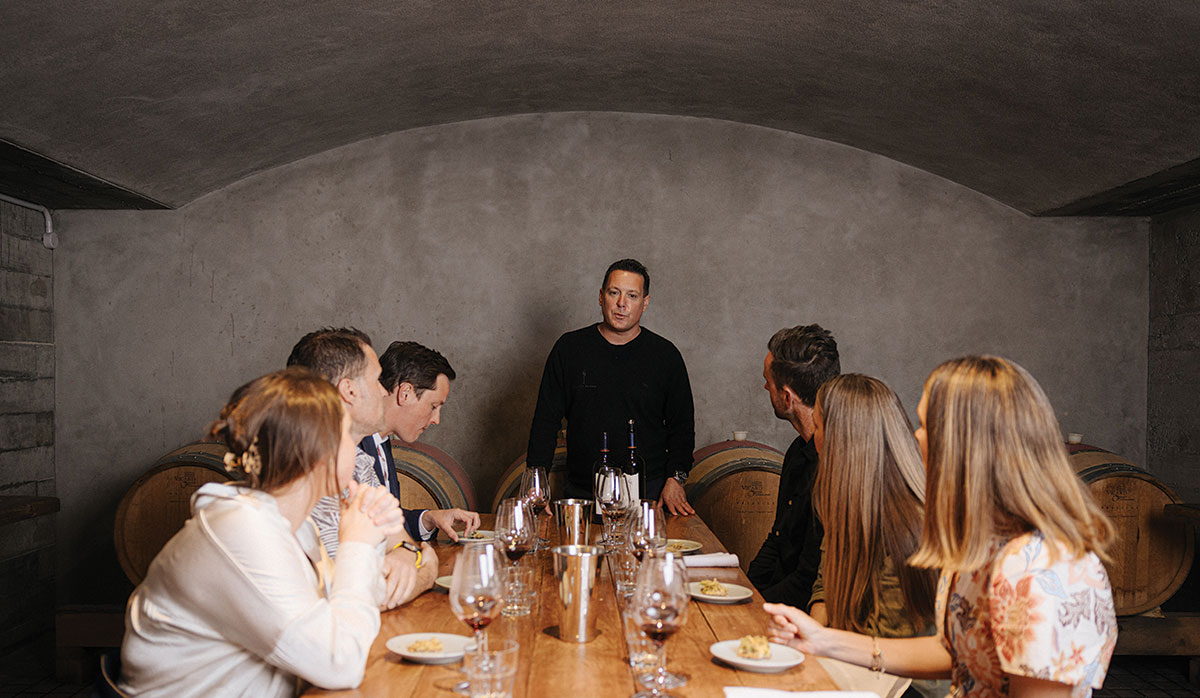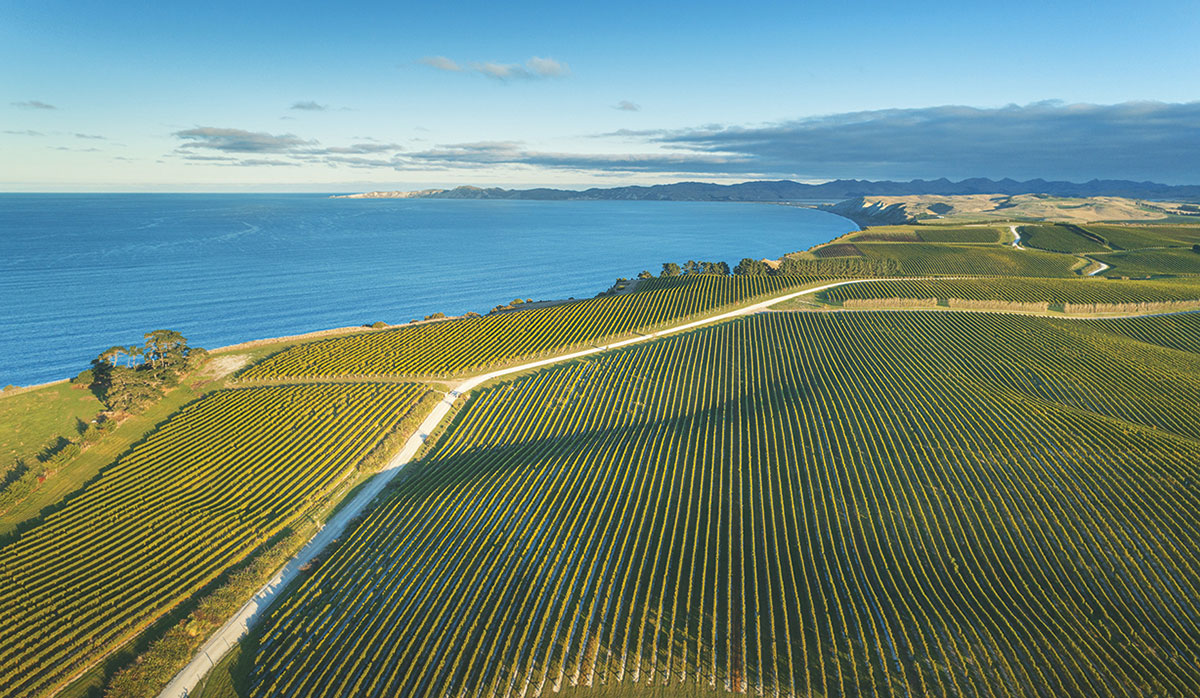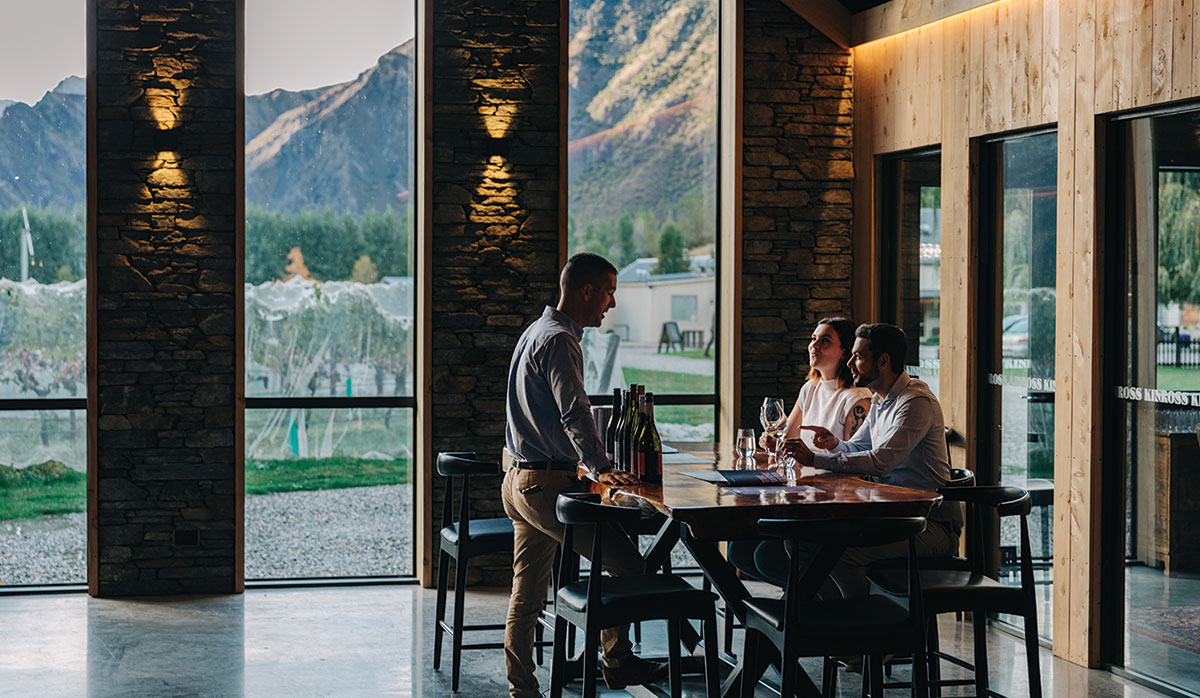Rippon: Personal, Sustainable Wine Experiences Redefined
In 2019, Rippon restructured its Wānaka cellar door, shifting from walk-ins to appointment-only tastings, capped at six guests per half hour.
Wine tourism has evolved into a sophisticated, diverse and resilient part of the New Zealand wine sector's economy. Emma Jenkins MW talks to wineries offering a warm welcome, from authentic cellar interactions to flagship premium experiences.
No longer confined to casual tastings at the cellar door counter, wine tourism has matured into a complex and economically significant part of New Zealand's wine industry. In 2024, around 759,000 international visitors (23% of all arrivals) visited a winery or vineyard, spending on average 47% more than other travellers. Together wine and food tourism contribute an estimated NZ$1.4 billion annually. Meanwhile, domestic tourism is above pre-pandemic levels. New Zealand Winegrowers intel indicates a shift towards pre-booked premium tasting experiences (assisted by 2024's cellar door law changes), stronger direct-to-consumer (DTC) sales, and demand for cycle-trail and sustainability-led experiences.
For wineries, wine tourism can bring profitable DTC sales, but also longer-term opportunities, cultivating loyalty through wine clubs and online purchases, diversifying income streams, and building brand awareness and advocates who carry their stories home. "By the time they leave, we want to have created such a powerful impression that they are connected to the place, and by extension, the wines," says Peter Jones from The Landing.
Wine tourism is increasingly defined by its breadth. At one end are destination properties combining wine with luxury accommodation, fine dining and events. These wineries present wine as part of a premium lifestyle, entwined with architecture, landscapes and hospitality. At the other end are often smaller producers, focused on intimacy and authenticity, with small group tastings, vineyard walks, or educational experiences that reinforce their identity and build vital name recognition in export markets. “Our presence in global markets is enhanced by local wine tourism,” says Sonya Coutts, Head of Hospitality at Palliser Estate. “Many overseas tourists go on to purchase our wine products back in their home country.” That’s a two way street, she adds, talking of tourists who have enjoyed Palliser wines at home, “so then feel compelled to visit us in person when in New Zealand”.
Wine tourism is increasingly defined by its breadth. At one end are destination properties combining wine with luxury accommodation, fine dining and events. These wineries present wine as part of a premium lifestyle, entwined with architecture, landscapes and hospitality. At the other end are often smaller producers, focused on intimacy and authenticity, with small group tastings, vineyard walks, or educational experiences that reinforce their identity and build vital name recognition in export markets. “Our presence in global markets is enhanced by local wine tourism,” says Sonya Coutts, Head of Hospitality at Palliser Estate. “Many overseas tourists go on to purchase our wine products back in their home country.” That’s a two way street, she adds, talking of tourists who have enjoyed Palliser wines at home, “so then feel compelled to visit us in person when in New Zealand”.
Of course, wine tourism is not all a bed of roses. Investment can be costly, and success is not guaranteed. Delivering great hospitality requires skillsets distinct from those of winegrowing. There is risk of over-commercialisation or diluting authenticity, while sustainability pressures loom if visitor numbers are poorly managed. The pandemic abruptly underscored the dangers of relying too heavily on international visitors. Yet such challenges have spurred on experimentation and diversification, prompting wineries to decide whether tourism is central to their business, a supplementary channel, or perhaps not a viable avenue.
The Urban Winery
When Tony Bish Wines opened The Urban Winery in Napier’s Art Deco National Tobacco Building in 2017, it became the country’s first urban winery. Visitors can taste wines, enjoy pizza and peer through a large glass window into the barrel room, where a giant golden wooden egg glows among the more typical barrels and concrete eggs. Exports and Operations Manager Maxime Cavey says the location fits seamlessly into the Hawke’s Bay wine circuit, aided by its bike trails. “We probably see more locals and repeat visitors being in an urban environment, and the location allows us to service visitors when other cellar doors are closed, or if short on time. Cruises don’t stay in town long enough to head into the countryside.”
Challenges do exist, including people expecting wineries to be in the countryside among vines, and the site’s limited outdoor space. Still, during cooler months, the venue’s cozy ambiance provides an advantage. Maxime believes urban wineries are increasingly vital, especially in Great Wine Capitals like Hawke’s Bay. “They offer a slice of our great wines without having to travel too far.
Craggy Range
From its inception, Hawke’s Bay’s Craggy Range envisioned an immersive environment, where luxury accommodation and fine dining were inseparable from fine wine. Kristine Kilpatrick, Head of People and Hospitality, explains: “By integrating hospitality into the brand, we aimed to extend the storytelling beyond the bottle and deepen engagement with our consumers.” Success is measured by both revenue – accommodation, restaurant bookings and cellar door sales – and brand prestige. Craggy Range has been included in the World’s Best Vineyards list, received Cuisine’s 2025 Winery Restaurant of the Year (with Casey McDonald also named Chef of the Year), and achieved a Gold Sustainable Tourism Business Award.
 |
|---|
|
Curated experiences at Craggy Range. |
The lessons are clear, Kristine says. “Operating in the luxury space requires consistency across every touchpoint, personalisation through curated experiences, and a strong internal culture that empowers staff to deliver exceptional service.” The rewards include diversified revenue and deepened loyalty, but Kristine believes such high-end style also serves as a flagship in New Zealand wine tourism. “These experiences play a big role in attracting international visitors seeking premium offerings and elevate the perception of New Zealand as a world-class wine destination,” she says. “They also drive regional tourism and support local economies by encouraging longer stays and higher spend.”
Palliser Estate
Martinborough’s compact scale has helped shape Palliser Estate’s style of wine tourism. “It makes visiting by foot or by bike feel effortless, and we see it as part of the charm of the region,” says Sonya Coutts. As one of Martinborough’s earliest wineries, Palliser is already a popular destination, but Sonya notes that many visitors appreciate the opportunity for a wine trail experience, typically stopping by two to four wineries.
Collaboration is key and Palliser works closely with neighbours Oraterra, Nga Waka, and Parehua Resort, as well as operators such as Green Jersey Bikes, which help extend the range of wineries people can visit. This is both strength and challenge – raising the profile of the region but requiring each producer to deliver something unique, while maintaining a consistently high standard. Palliser aims to offer an experience that is premium yet approachable – visitors might opt for a fine dining-style tasting menu or just as happily arrive in walking or cycling shoes for a casual glass and a charcuterie board.
Collaboration is key and Palliser works closely with neighbours Oraterra, Nga Waka, and Parehua Resort, as well as operators such as Green Jersey Bikes, which help extend the range of wineries people can visit. This is both strength and challenge – raising the profile of the region but requiring each producer to deliver something unique, while maintaining a consistently high standard. Palliser aims to offer an experience that is premium yet approachable – visitors might opt for a fine dining-style tasting menu or just as happily arrive in walking or cycling shoes for a casual glass and a charcuterie board.
Flaxmore Vineyards
Flaxmore Vineyards in Nelson has built a uniquely personal niche, pairing wine with art and the local landscape. Owners Stuart and Patricia (P) Anderson say their vineyard walk and gallery were inspired by a desire to create “a unique experience to complement the wine tasting”, making the most of panoramic Moutere Valley views and their passion for abstract art. Their ‘Wine, Art and Walk’ attracts a broad mix of visitors. “Many come for one thing but are pleasantly surprised by another,” says P, although wine typically remains the centrepiece. Guests are personally hosted by the Andersons, who weave stories of their land, sustainability projects, and viticulture. Plans are underway to add information boards along the walk.
The gallery, featuring local artists and Stuart’s abstract photography, reinforces the sense of place. “Art and wine pair so well… our art is strongly influenced by landscapes and nature,” Stuart says. Though labour-intensive, their personal approach has delivered significant benefits. The cellar door now provides an important high-margin sales channel, allowing Flaxmore to remain small, with many visitors evolving into loyal online customers, strengthening both Flaxmore’s brand and Nelson’s reputation as a vibrant wine and cultural hub.
Yealands Estate
At Yealands Estate in Marlborough’s Awatere Valley, eco-tourism is a continuation of the winery’s founding ethos. Established in 2008 as the world’s first winery to be certified carbon zero from inception, Yealands continues to lead with large-scale sustainability initiatives that now form the backbone of its visitor experiences. “Our sustainability initiatives define us, so it was a natural fit to develop a tour around these,” says Katie Covell, Cellar Door and Events Manager.
The White Road Tour, a seven-kilometre journey through the coastal vineyards, is now in its first full season. Along the route, which can be walked, cycled or driven, visitors enjoy sweeping views of the Pacific Ocean while encountering butterfly gardens and wetland reserves, solar farms and kune kune pigs, compost and chickens, along with other biodiversity and carbon reduction projects. Signage and picnic areas encourage people to pause and connect with the land, and they can enjoy hands-on moments such as planting a native tree in the Station Creek Reserve, Katie says. “Not only do they offset a little of their carbon footprint, but they also leave something of themselves at Yealands.”
She believes the benefits go beyond tourism. “A cellar door isn’t just about sales - it’s about education, positive reputation and building lifelong advocacy. Wine tourism is a valuable cog in the wheel.” To be truly ‘sustainable’, wineries need to ensure that every part of their business is encompassed, including wine tourism, she says. “It’s about remembering the Tiaki Promise - a commitment to care for New Zealand, safeguarding its natural environment, culture, and heritage for future generations.” By aligning their environmental innovation with authentic visitor experiences, Yealands underscores that sustainability is not just a practice but can also be a valuable shared experience.
 |
|---|
|
"Our sustainability initiatives define us, so it was a natural fit to develop a tour around these." Katie Covell from Yealands |
Black Estate
At Black Estate in North Canterbury, the winery restaurant is inseparable from the vineyard it overlooks, connecting visitors directly with the estate’s organic and regenerative farming. Co-owner Pen Naish says guests are introduced to the restaurant via a driveway past two vineyard blocks. “Diverse weeds, cover crops, under vine cultivators, sheep, cows, and the ambience of living soil all set the scene.” That ethos extends to the menu: for more than a decade Black Estate has served only organic, biodynamic and spray-free produce, recently adding their own regeneratively-raised beef. Running a restaurant while winegrowing brings challenges: “In a relatively isolated area, it is demanding from a staffing and foot-traffic perspective,” Pen says. “During the growing season and harvest we’re going full tilt in both areas, which can be exhausting, but the upside is that winter becomes a much more relaxed season.”
For Pen, food is central to storytelling. “A glass of wine with a plate of food in a beautiful place is a more open experience than an analytical tasting,” she says. “When the food and wine come from the same region, grown in the same climate, there’s synergy – layers that truly express place.” In Pen’s view, winery restaurants are central to regional tourism, encouraging visitors to slow down, connect with people and landscapes, and experience wine in its fullest context.
Kinross
Kinross has built a distinctive role as a multi-winery cellar door in Gibbston, representing four labels – Valli, Wild Irishman, Hawkshead, and High Garden – alongside its own Kinross label. Chief Executive Nicky Sygrove describes it as pragmatic collaboration. “Why would Grant Taylor at Valli want to spend time managing licences, staffing, and compliance when he could focus on what he loves and does best – growing and winemaking? For us, the opportunity was to bring these producers together and create a stronger wine destination – they don’t compete, all are celebrated.”
 |
|---|
|
"The collective model is absolutely a key drawcard that we promote as a point of difference." Nicky Sygrove |
Tastings are designed to showcase subregional differences and highlight the varying stories of people and places. Alongside this are vineyard tours, educational experiences, the Kinross Bistro and cottage accommodation set amongst the vines. This breadth has positioned Kinross as much a tourism business as a wine business, earning it the inaugural Qualmark New Zealand Wine Tourism Award in 2024. “Visitors to the region might be weighing up a visit to us alongside a jetboat ride, a bungy or a round of golf,” Nicky notes. “The collective model is absolutely a key drawcard that we promote as a point of difference. Equally important is our location, which is not something we take for granted, and we are lucky to have the Kawarau cycle trail opening in the next six months, which will hopefully bring more visitors to our valley.”
The large 2025 harvest will exacerbate the wine industry's "lingering" supply from recent vintages, New Zealand Winegrowers Chief Executive Philip…
If you find a new consumer in a developed wine market, you are taking them from someone else, says Blank…
With the stars of Matariki to rise in June, Jeff Sinnott, a member of the Tuku Māori Winemakers Collective, looks at…